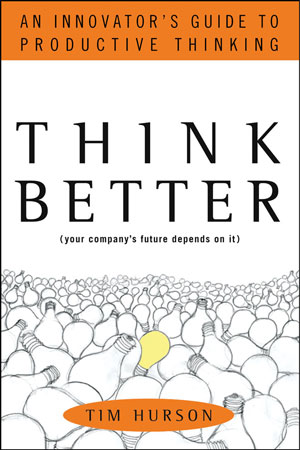Think Better Summary
5 min read ⌚
 An Innovator’s Guide to Productive Thinking
An Innovator’s Guide to Productive Thinking
The ability to think well is something which makes humans, as a species, so unique in the animal kingdom. However, the ability to think better is something which makes certain humans innovators.
Fortunately, you can learn how to do it. And that’s exactly what Tim Hurson’s “Think Better” is about.
About Tim Hurson
 Tim Hurson is a motivational speaker and creativity theorist. Born in Johannesburg, South Africa, he spent most of his adult life in Toronto and is currently a Canadian citizen. He has written two paradigm-shifting books, “Think Better” and “Never Be Closing.”
Tim Hurson is a motivational speaker and creativity theorist. Born in Johannesburg, South Africa, he spent most of his adult life in Toronto and is currently a Canadian citizen. He has written two paradigm-shifting books, “Think Better” and “Never Be Closing.”
“Think Better Summary”
You know how to think, right?
After all, you’re doing it all the time! Even now, while you’re reading this sentence, you’re thinking about what you’ll eat for lunch today or whether you’ll make it in time to pick up the kids from school.
See the problem?
That’s thinking, all right; but, it’s certainly not good thinking!
In order to do that – first of all, you need to focus and avoid distractions. Or, to use the Hurson’s terminology from “Think Better” to leave behind the animal brains and get a human one.
Because, if you’re constantly jumping from one thing to another, you’re using your “monkey mind” and nothing more. On the other hand, if you’re merely thinking about surviving, eating, having sex or fleeing, you’re using your reptilian, “gator brain”.
Finally, if you’re a conformist, your brain is suffering from a severe case of “elephant tether.” You see, elephant trainers in India teach the small elephants that they cannot break the chains; so, when they get older, they don’t even try doing it.
As a human being there are two ways to think about things: reproductively, and productively. It’s important to understand each of them and even more important to understand how to use them.
Reproductive thinking is based on the power of recombining and its goal is to save your brain some energy. It has three levels.
The first one is “the unconscious”. It’s what you do when you ride your bike or brush your teeth. No need to reinvent this: it’s good the way it is for all eternity.
The second one is the “intentional”. Or, better known as “the checklist method”. Standardized procedures are good if you’re a doctor or a pilot. You’re not supposed to rethink anything in either case. Just follow the practice.
Finally, the third level of reproductive thinking is what the Japanese refer to as “kaizen.” It means “good change” or “continuous improvement.” In other words: reproducing with a style and one or two mindful upgrades.
Productive thinking is the next stage of thinking. It’s not merely “kaizen” – or “good change” – but “tenkaizen” – or “good revolution.” In other words, you’re not just adding improved spikes to the wheel, but you’re reinventing it altogether.
And productive thinking consists of two “thinkings”: creative and critical thinking. Creative thinking is the part when you get all the ideas. Critical thinking is the part when you analyze them. People usually make the mistake of confusing them, not understanding that new ideas are weak and that critical analysis should come later, and not during the expansive process of creating something new.
Tim Hurson is famous for developing his unique ThinkX Productive Thinking Model. It’s a six-step process, which strives to help people think better.
The first stage is the “What’s Going On?” stage; it’s all about determining what makes you think about a new solution the current situation. Secondly, it’s the “What’s Success” stage, when the thing in focus is your vision. Next, you move on to “What’s the Question?” phase, when you need to focus on finding the right questions.
Step 4, finally, is generating answers. Which will lead you to Stage 5, or “Forging the Solution.” This is a good moment to use the POWER method, namely, reviewing your ideas in terms of positives, objections, what else-s, enhancements and remedies.
The final step is “Aligning the Resources.” Or the EFFECT stage, when you need to plan six things: energy, funds, free time, expertise, conditions, and things to do.
Key Lessons from “Think Better”
1. You Have Three Animal Brains Inside Your Mind
2. There Are Two Ways of Thinking: Reproductive and Productive
3. Productive Thinking Consists of Creative and Critical Thinking
You Have Three Animal Brains Inside Your Mind
Even though you’re a human, that doesn’t mean you’re thinking the way a human can. In fact, animals are capable of thinking about most of the things you think about – in the exact same way you think about them. In fact, you have three different animal brains inside your mind.
A monkey mind – which makes you jump from one thing to another. A gator brain – which makes you think about survival. And an elephant tether – which makes you a conformist.
There Are Two Ways of Thinking: Reproductive and Productive
There are two ways to think of things: reproductive and productive.
The idea behind reproductive thinking is a fairly simple one: you reproduce existing patterns. And you can do this in one of three ways: unconsciously, intentionally, or kaizen. You reproduce things unconsciously when you’re driving a car; intentionally – when you’re following procedures; and the kaizen-way when you’re improving them through repetition.
Productive thinking means producing something new, revolutionizing things, or “tenkaizen”. It’s, of course, what original and creative people do.
Productive Thinking Consists of Creative and Critical Thinking
Productive thinking consists of two parts: creative and critical. The creative part is when you’re brainstorming ideas. It’s the more powerful – but the simpler one as well. The critical part is what’s difficult. Tim Hurson has developed a six-step process through which you can master it.
It starts with defining the problem – and then envisioning the perfect solution. The following two steps are asking the right questions and generating strong answers. You move to the solution only in step 5. And you plan how to do it – in the final, sixth step.
Like this summary? We’d like to invite you to download our free 12 min app, for more a stamazing summaries and audiobooks.
“Think Better” Quotes
All models are wrong. At best they are imperfect reflections of reality. Share on X A plan is a thing, an organized set of data marshaled around targets and timelines. Share on X All of us have had the experience of coming up with a ‘solution’ to a problem that hasn’t done anything to solve the problem or that’s made the problem even worse. Share on X Uncertainty is pain. Astonishingly, in some cases even more painful than death. Share on X Our minds hate not interpreting, not closing in on answers. When we do close in on one answer or interpretation, we effectively block out any others. Share on X
Emir is the Head of Marketing at 12min. In his spare time, he loves to meditate and play soccer.


 An Innovator’s Guide to Productive Thinking
An Innovator’s Guide to Productive Thinking



